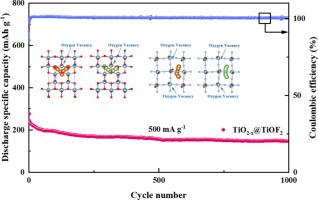通过TiO2-x@TiOF2异质结构阴极实现Mg2+/Li+混合离子电池的高性能:实验和计算见解
IF 6.9
2区 材料科学
Q2 CHEMISTRY, PHYSICAL
引用次数: 0
摘要
通过hf辅助水热法制备TiO2-x@TiOF2异质结构,并进行后续热处理。在Mg2+/Li+混合离子电池中,TiO2-x@TiOF2异质结表现出优异的电化学性能,包括在500 mA g−1时具有275.8 mAh g−1的高初始放电容量,在1000 mA g−1时具有128.6 mAh g−1的优异倍率容量,以及在1000 mA g−1下1000次循环后具有62.5 %的优异循环稳定性。第一性原理计算表明,TiO2@TiOF2异质结构中Mg2+和Li+的迁移势垒低于纯TiO2和TiOF2中的迁移势垒。氧空位的引入进一步降低了这些迁移障碍,证实了异质结构和氧空位对提高电化学性能都起着至关重要的作用。此外,长时间循环后的后期表征表明TiO2@TiOF2的储能机制是基于Mg和Li离子的共插层。长期循环条件下的容量衰减主要是由于插入离子的不完全脱嵌引起的。通过原位构建异质结构和在过渡金属氧化物中引入氧空位,为设计高性能Mg2+/Li+混合离子电池正极材料提供了一条新途径。本文章由计算机程序翻译,如有差异,请以英文原文为准。


High performance of Mg2+/Li+ hybrid ion batteries achieved through TiO2-x@TiOF2 heterostructure cathodes: Experimental and computational insights
The TiO2-x@TiOF2 heterostructure was fabricated via an HF-assisted hydrothermal method followed by subsequent thermal treatment. In Mg2+/Li+ hybrid ion batteries, the TiO2-x@TiOF2 heterojunction exhibited outstanding electrochemical performance, including a high initial discharge capacity of 275.8 mAh g−1 at 500 mA g−1, excellent rate capability of 128.6 mAh g−1 at 1000 mA g−1, and superior cycling stability with a capacity retention of 62.5 % after 1000 cycles at 1000 mA g−1. First-principles calculations indicate that the migration barriers for Mg2+ and Li+ in the TiO2@TiOF2 heterostructure are lower than those in pure TiO2 and TiOF2. The introduction of oxygen vacancies further reduces these migration barriers, confirming that both the heterostructure and the oxygen vacancies play crucial roles in enhancing the electrochemical performance. Furthermore, post-characterization following prolonged cycling revealed that the energy storage mechanism of the TiO2@TiOF2 is based on the co-intercalation of Mg and Li ions. The capacity decay under long-term cycling conditions is primarily attributed to the incomplete de-intercalation of the intercalated ions. This work provides a novel approach for designing high-performance cathode materials for Mg2+/Li+ hybrid ion batteries by in situ constructing heterostructures and introducing oxygen vacancies in transition metal oxides.
求助全文
通过发布文献求助,成功后即可免费获取论文全文。
去求助
来源期刊

Applied Surface Science
工程技术-材料科学:膜
CiteScore
12.50
自引率
7.50%
发文量
3393
审稿时长
67 days
期刊介绍:
Applied Surface Science covers topics contributing to a better understanding of surfaces, interfaces, nanostructures and their applications. The journal is concerned with scientific research on the atomic and molecular level of material properties determined with specific surface analytical techniques and/or computational methods, as well as the processing of such structures.
 求助内容:
求助内容: 应助结果提醒方式:
应助结果提醒方式:


